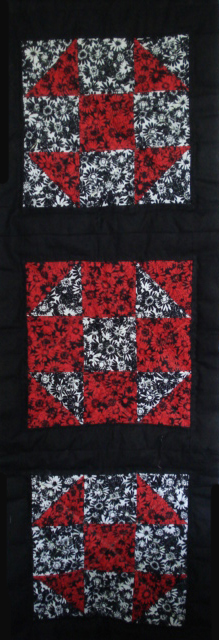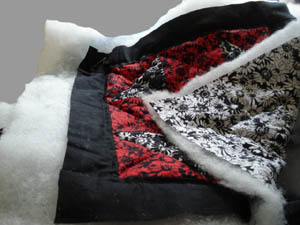Yesterday I went to the second part of a two-part workshop on how to do “Quilting-as-you-go” tutored by Carolyn Forster.
On the first day, six weeks ago, she showed us masses of her quilts made using this method.
Then we had the tough job of deciding which block design we would make and we began cutting up fabric and piecing our blocks.
She showed us how each block was sandwiched together and quilted as an individual block, just leaving a couple of inches of the “frames” unquilted so that they could be joined together later.
Each of the completed blocks measures 16″ x 16″ and I have 35 of them all quilted up and ready to join together in rows. Each row will consist of 5 blocks and will have 7 rows, so it will be quite a big quilt. As they say in the US “you do the math(s)”.
On the left you can see one completed block, made up of a sandwich of: a pieced top, wadding, backing fabric. On the right is a bag containing the remaining 30 blocks waiting to be joined together in another 6 rows.
Not content with having been immersed in sewing all day I was so inspired by seeing Carolyn’s sweet little drawstring, circular needlework bag that I had to cut out and try to make one myself. Inside it had six pockets for reels of thread etc. i also made a matching needlecase. I can’t show it to you because I have packed it all up to send to a friend of mine. She has moved several times in the last few years and when I visited her in her latest home I was horrified that serial clearouts had left her without a sewing bag/box. She confessed to me that she had no needle and thread in the whole house. She has been on my mind since I discovered this distressing situation and now I hope that my late-night sewing session will ensure that her new home is complete.
On the reading front I forgot to tell you about the recently completed “An Artist of the Floating World” by
Kazuo Ishiguro. This lets us into the world of an artist in post-war Japan. Those who have read “The Remains of the Day” will be familiar with the author’s gentle measured style of writing which suits this story in which a widowed artist is faced with arranging a marriage for his second daughter. We experience with him the difficulties of adapting to social and political changes which have a direct effect on his immediate family.
i have moved on to “Eucalyptus” by Murray Bail which coincidentally also deals with how to ensure that a suitable partner is found for a daughter. We may laugh at Jane Austen’s Mrs Bennett and Emma with their matchmaking preoccupations but both books that I mentioned above emphasise that the problem is still uppermost in the minds of many a parent and friend. The quilt I am making is for my only daughter. She should really be making it herself as part of her bottom drawer and I should be making use of the ladies at my quilting bee to search out a spouse for her.



Leave a comment